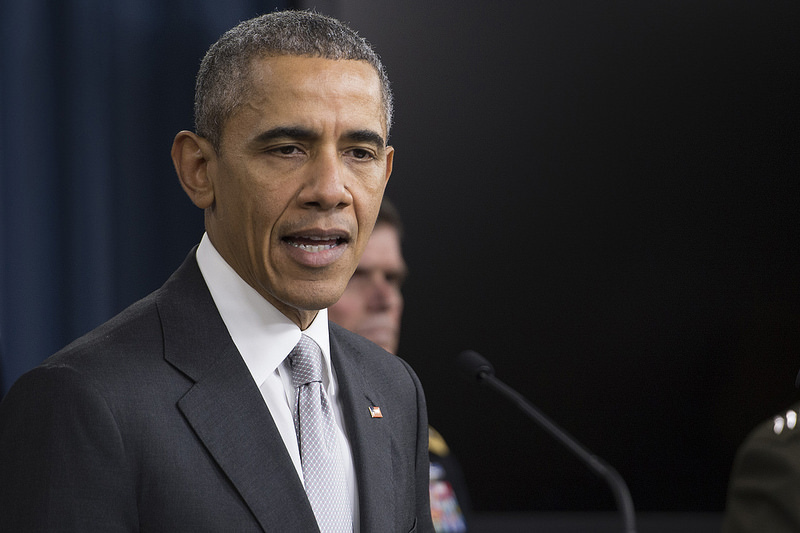Throughout Donald Trump’s first term in office, the US president has harked back to the Obama years. From blasting the “horrible” Iran nuclear deal to blaming Barack Obama’s administration for the “obsolete, broken system” that Trump claims has hindered the US response to the COVID-19 crisis, he’s used his predecessor as a constant foil.
During his 2016 campaign for the White House, Trump committed himself to rolling back much of the Obama legacy. Now, his 2020 election opponent is Obama’s former vice president, Joe Biden. This ensures that the choice American voters make at the ballot box in November will either reinforce Obama’s legacy – or rebut it once again.
It’s not always easy to pinpoint the exact legacy a president leaves behind, particularly in the short term. Sometimes, political legacies that appear immediately important can diminish in significance over time. Or those that initially seemed flat – such as that of Harry Truman – come to be seen in a much more positive light as the years pass.
For Obama, the successes he enjoyed and disappointments he endured after his election in 2008 were often a consequence of the political environment in which he operated. Once Republicans took control of the House of Representatives in January 2011, the scope for legislative action dramatically diminished and his administration had to find other ways to get things done. Such routes included executive actions as well as presidential memoranda.
During the 2016 campaign, candidate Trump declared that he would “cancel every unconstitutional executive action, memorandum and order issued by President Obama.” Yet, while executive actions are simpler to reverse than legislative achievements, there are still procedural obstacles to overcome if a predecessor’s actions are to be rolled back. And these obstacles were not always given due attention by the Trump administration.
Nor was America’s institutional fragmentation brushed away with a new broom once Trump entered the White House. Like Obama, he enjoyed two years when his party controlled both houses of Congress – until the Republicans lost their majority in the House of Representatives in the 2018 mid-term elections. This limited Trump’s capacity to continue unpicking his predecessor’s achievements.
In a new book, we’ve looked at what kind of legacy Obama left as well as what success Trump has had in trying to roll it back. We’ve found that while some aspects of the Obama legacy were vulnerable to reversal, other areas proved more resilient. The stand-out legacies of the Obama years would become a direction of travel, if not always an end point.
Here we will look at four key areas: healthcare, immigration, climate policy and racial justice.
Healthcare
The standout domestic policy legacy of the Obama administration was the Affordable Care Act (ACA), also known as Obamacare. Enacted in early spring 2010, ACA was the most significant policy reform of the US healthcare system since the 1960s. While the new law built on existing programmes such as Medicare and Medicaid, rather than replacing them, it significantly expanded the government’s role in funding healthcare and the regulation of the private health insurance market.
At the signing ceremony for the bill, Biden was caught on microphone describing the moment as a “big fucking deal”. Republicans agreed with this sentiment and spent much of the remainder of Obama’s presidency declaring their aim to repeal the law. After taking control of the House in January 2011, Republicans passed multiple bills to repeal all or parts of the ACA. But while Obama remained in office, with a power to veto these bills, this remained symbolic rather than substantive politics.
Yet that symbolism mattered. It meant that the law remained contested and that Republican controlled state-level governments, such as Texas with its large uninsured population, did not cooperate with implementing key aspects of Obamacare. When Republicans took control of the White House and both chambers of Congress in January 2017, the outlook for the preservation of Obamacare looked bleak.
But despite Trump’s promises to “repeal and replace” the ACA, it is still the law of the land as his first term draws to a close. In 2017, the Republican-led House passed the American Health Care Act, which would have repealed large parts of the ACA. Although the Republican leadership bent all the Senate’s norms to breaking point, no equivalent legislation passed in the upper house and Obamacare remained.
In fact, the Republican efforts to undo the law seem to have been central to a growth in popularity for the ACA. Throughout Obama’s time in office, a plurality of Americans said that they viewed the law unfavourably, but that shifted once it came under sustained threat and reports emerged of how many people would lose insurance should it be repealed.
It also became clear that the sheer complexity of the law made it difficult to unravel if Republicans were to keep in place its popular aspects, notably protections for people with pre-existing medical conditions. In addition, the new president’s manifest frustration at the complex details of health policy made him an ineffective broker in negotiations.
Efforts have continued throughout the Trump presidency to undermine the application of Obamacare. The administration is backing a court case that will be heard by the Supreme Court a few days after the November election that could bring the ACA crashing down.
Meanwhile, healthcare remains a key battleground in the 2020 election, particularly in the midst of a pandemic. Confounding logic, Trump claims that Biden would threaten protections for Americans with pre-existing health conditions and that these protections will only be preserved if he is re-elected. But these protections exist as a result of the ACA, which the Justice Department is trying to bring down.
All this means the ACA is an Obama legacy that has proved more resilient than expected when Trump took office in 2016.
Immigration
Obama’s legacy in other areas was more mixed and relied less on legislative action than efforts to use the executive power of the presidency. A good example was immigration. The Obama administration’s promise of comprehensive reform didn’t really come close to making it through Congress, even when the Democrats controlled both chambers.
Obama did use his executive power to introduce the Deferred Action for Childhood Arrivals (DACA) policy in mid-2012. This provided temporary legal status to so-called “Dreamers”, people who had been brought into the US without documentation as children and who were deemed illegal despite many having lived their lives as Americans. A subsequent executive action, which would have granted legal status to a much wider group, never came into force as it was thwarted by the courts in 2016. This left DACA as Obama’s major legacy in terms of immigration policy.
As an executive order it should have been relatively straightforward for the Trump administration to reverse. This seemed especially likely given how Trump had so remorselessly used his antagonism to “illegal immigration” as a campaign tool in 2016.
Trump did in fact express some ambiguous sentiments about the plight of the Dreamers, but in September 2017 he labelled DACA an “amnesty first approach” and declared that the protections the programme offered would start to be rolled back in six months. Yet in the summer of 2020, the Supreme Court ruled that the administration’s effort to reverse DACA was so fumbled as to fail to meet the relatively straightforward administrative procedure required to do.
This makes the 2020 election even more critical – especially for those people living in America who don’t have a vote. The Trump administration would surely try again to rollback DACA if re-elected and given a second chance to do so. Meanwhile, a Biden administration would likely try to codify the protection for Dreamers through legislation, and pursue further reform to offer a path to legal status for others living in the US without documentation.
Climate crisis
When it comes to action on climate change, Obama’s legacy was less tangible, and certainly more complex. The myriad layers involved in creating, executing and defending an agenda to combat the climate crisis made for inevitable problems to implement reform. This, combined with the heft of opposition, fake news and political baggage that accompanied the issue, made for a series of challenges, some victories and many disappointments for the Obama administration and those eager to embed a green government agenda during his two terms in office.
Trump’s decision to withdraw the US from the Paris Climate Agreement, which Obama’s administration signed in 2015, is often held up as an example of how he rolled back Obama’s legacy. But other reforms showed with clarity the push-pull nature of policy from the Obama to Trump administrations.
The Clean Power Plan (CPP), which set out to curb US greenhouse gas emissions, is one such story. Unveiled by Obama in 2015, the CPP was groundbreaking in a range of ways. It demonstrated that the world’s leading superpower acknowledged the existence of human-made climate change, and offered an initiative to reduce carbon emissions back to 2005 levels by 2030. A significant step forward in itself, the CPP looked to set a bar for other nations and give a warning to big polluters. So far, so environmentally good.
But the CPP quickly caused consternation with governors in dozens of states, who lost no time in taking legal action against a plan they viewed as a serious threat to the economy. By early 2016, 24 states were challenging the CPP in court, resulting in a Supreme Court decision to issue a judicial stay on Obama’s plan.
When Trump arrived in the White House, the path to undermining the plan was already paved. In March 2017, he signed an executive order requesting that the Environmental Protection Agency (EPA) carry out a review of the CPP. By this time, the agency was headed by former Oklahoma attorney general Scott Pruitt, known for his rejection of the climate crisis as a man-made phenomenon.
In June 2017, the US formally withdrew from the Paris Climate Agreement, and four months later, the EPA announced that the CPP would be repealed. These two developments were directly connected, as the CPP was a route via which the US would have met its modest Paris emissions targets.
With both Obama-era legacies unpicked, the Trump administration moved towards implementing its own, far more polluter-friendly option, the Affordable Clean Energy plan. In keeping with his repeal and replace approach to Obama policy, Trump’s plan did not place limits on greenhouse gases, an aim that was central to the CPP. Instead it opted for an “inside the fenceline” approach, imposing less than stringent restrictions on individual power plants.
By chance, the earliest possible date that the US can legally withdraw from the Paris Climate Agreement is November 4, 2020, one day after the presidential election. As part of his US$2 trillion plan for Climate Change and Environmental Justice, Biden has vowed that the US will re-engage with the Paris deal. This is significant for environmental reasons but also as a demonstration to external observers that a post-Trump America will take its international obligations seriously.
In direct contrast to the Trump environmental agenda, Biden has pledged that his presidency would move America, the world’s largest polluting country, towards 100% green energy use by 2050. Trump’s plan offers an America First-focused alternative, prioritising US energy independence via further use of fossil fuels. On the environment, as with many other policy areas, the polarised options on offer reflect the state of the nation.
Racial justice
There is one aspect of the Obama legacy that cannot be undone, and that is the moment he sealed victory in 2008. Obama ran, however unrealistically, on a post-racial election ticket in 2008, and the world watched as America elected a young, highly educated, politically progressive black man for the first time as leader.
In the early years of his administration, issues not overtly related to race remained at the forefront of the political agenda. Nonetheless, the 2008 economic collapse and the nation’s ongoing healthcare crisis further laid bare the disproportionate systemic challenges that Americans of colour continued to face. Throughout his time in office, Obama was criticised by those on the left of “racial procrastination”.
Inevitably, a moment would come when Obama would have to confront the race issue. It arrived via the 2013 acquittal of charges against police officer George Zimmerman for the fatal shooting of unarmed black high-school student, Trayvon Martin. After Zimmerman’s acquittal, Obama offered unusually personal reflections, stating that Martin “could have been my son”. He was lauded for his empathy and simultaneously criticised for stoking racial tensions.
The moment, combined with the lengthy list of other Americans of colour on the receiving end of police violence, often fatally, ignited the Black Lives Matter movement. This presented Obama with an ever-narrowing tightrope to walk as the calls for racial justice grew louder in a nation where not everyone had come to terms with a president whose heritage included Kenya as well as Kansas.
As it turned out, America opted in 2016 to turn its back on the progress embodied by the first black man in the White House. Instead, as the writer Ta-Nehisi Coates put it, the US elected the nation’s “first white president”. Coates argued that Trump’s victory was in no small part predicated on negating the racial legacy of his predecessor. Obama may have broken the glass ceiling, an achievement that no-one could undo, but a determined successor could substantially paper over those cracks – and Trump made every effort to do so.
Once in office, Trump did not pretend to prioritise issues around racial justice – and his administration took repeated steps to reverse the proactive measures started during the Obama administration to call out institutional racism. Notably, in the context of the demands of the Black Lives Matters protests, Trump’s attorney-general, Jeff Sessions, stopped investigations into local police forces that had begun in 2015 in the wake of protests in Ferguson, Missouri, after the police shooting of Michael Brown in the city the previous year.
As protests grew in response to the police killing of George Floyd, in May 2020, Trump drew widespread criticism for adding to already boiling tensions via divisive words.
November 2020 will present voters with very different visions of how to manage race relations in this divided era. A president Biden would be unlikely to pursue the more radical demands of Black Lives Matters activists such as defunding the police, but there would probably be a change in tone from Trump’s confrontational language and a reintroduction of Justice Department investigations into local police forces.
The issues we’ve focused on here are a way to illustrate the strands of Obama’s legacy that Trump was so eager to dismantle. There are numerous further examples which show how Trump was determined to pursue a process of “de-Obamafication”. With the assistance of Republicans in Congress, and the agency heads he appointed, Trump succeeded in some, although far from all, of his rollback plans.
As voters head to the polls in November, they are faced with starkly different candidate choices. The US will have the opportunity to add another coat of whitewash over eight years of progressive efforts by its first black president, or reward the Biden half of the 2008 ticket – thereby reinforcing much of the Obama legacy. The stakes are high and the consequences of the choice facing voters is profound.



 Thousands Protest in Brazil Against Efforts to Reduce Jair Bolsonaro’s Prison Sentence
Thousands Protest in Brazil Against Efforts to Reduce Jair Bolsonaro’s Prison Sentence  Trump Weighs Reclassifying Marijuana as Schedule III, Potentially Transforming U.S. Cannabis Industry
Trump Weighs Reclassifying Marijuana as Schedule III, Potentially Transforming U.S. Cannabis Industry  Trump Sues BBC for Defamation Over Edited Capitol Riot Speech Clip
Trump Sues BBC for Defamation Over Edited Capitol Riot Speech Clip  Jimmy Lai Convicted Under Hong Kong National Security Law in Landmark Case
Jimmy Lai Convicted Under Hong Kong National Security Law in Landmark Case  U.S. and Mexico Reach New Agreement to Tackle Tijuana River Sewage Crisis
U.S. and Mexico Reach New Agreement to Tackle Tijuana River Sewage Crisis  Sydney Bondi Beach Terror Attack Kills 16, Sparks Gun Law and Security Debate
Sydney Bondi Beach Terror Attack Kills 16, Sparks Gun Law and Security Debate  Hong Kong Democratic Party Disbands After Member Vote Amid Security Crackdown
Hong Kong Democratic Party Disbands After Member Vote Amid Security Crackdown  Trump Taps Former DHS Official Troy Edgar for U.S. Ambassador Role in El Salvador
Trump Taps Former DHS Official Troy Edgar for U.S. Ambassador Role in El Salvador  Trump’s Rob Reiner Remarks Spark Bipartisan Outrage After Tragic Deaths
Trump’s Rob Reiner Remarks Spark Bipartisan Outrage After Tragic Deaths  U.S. Suspends UK Technology Deal Amid Trade Disputes Under Trump Administration
U.S. Suspends UK Technology Deal Amid Trade Disputes Under Trump Administration  Lukashenko Says Maduro Welcome in Belarus Amid Rising U.S.-Venezuela Tensions
Lukashenko Says Maduro Welcome in Belarus Amid Rising U.S.-Venezuela Tensions  Zelenskiy Signals Willingness to Drop NATO Bid as Ukraine, U.S. Hold Crucial Peace Talks in Berlin
Zelenskiy Signals Willingness to Drop NATO Bid as Ukraine, U.S. Hold Crucial Peace Talks in Berlin  European Leaders Tie Ukraine Territorial Decisions to Strong Security Guarantees
European Leaders Tie Ukraine Territorial Decisions to Strong Security Guarantees  Belarus Frees Opposition Leaders Maria Kalesnikava and Viktar Babaryka in U.S.-Brokered Deal
Belarus Frees Opposition Leaders Maria Kalesnikava and Viktar Babaryka in U.S.-Brokered Deal  U.S. Offers NATO-Style Security Guarantees to Ukraine as Peace Talks Show Progress
U.S. Offers NATO-Style Security Guarantees to Ukraine as Peace Talks Show Progress  European Leaders Launch International Claims Commission to Compensate Ukraine for War Damage
European Leaders Launch International Claims Commission to Compensate Ukraine for War Damage  Trump Administration Moves to Keep TransAlta Coal Plant Running Amid Rising AI Power Demand
Trump Administration Moves to Keep TransAlta Coal Plant Running Amid Rising AI Power Demand 


































